Nest and Egg Identification Resources
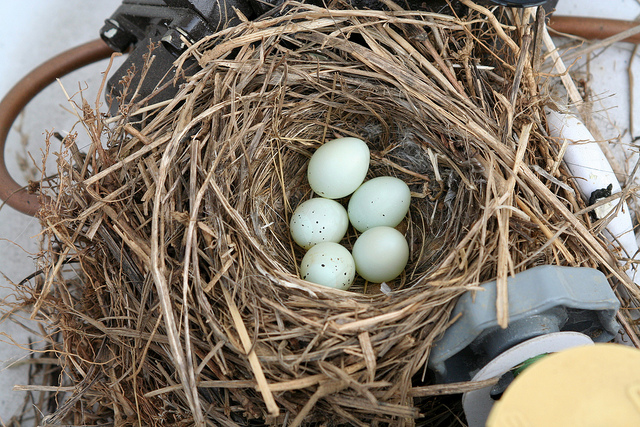
Bird Nest and ID Suggestions
Often times, when walking in the woods, or tending a garden, you'll see a bird nest, but no bird, only eggs or hatchlings. Adult birds are quite savvy about spotting approaching humans, and often fly off and observe their nest from a distance, making it hard to identify which bird belongs to which nest. This post is a rough first start at identifying some common Eastern US bird nests, and some resources you can use to help you with your identification.
Before you begin looking:
Before you begin trying to figure out the bird nest that you have found, a few words of caution:
- Predators can smell you. Even though smell is not as integral to our lives as predators like cats, raccoons, skunks, and foxes, it's still something to be aware of. When you walk to a nest, or around it, you are leaving a scent trail, which is an open invitation to predators. Try to avoid going directly up to a nest, touching a nest, or walking around it to lessen the danger to baby birds.
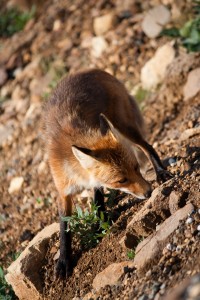
- If you can, watch the nest you find from a distance. Use binoculars to check it out, and try to keep away. If you inadvertently come upon a nest, then walk around in circles, and keep moving away from the nest. Stop at other random places, and try to leave a scent trail that does not stop at the nest. When doing bird research I would even take off my smelly shirt or socks and rub them on trees and rocks, well away from the nest, and walk on.
- Do not reach into nests or remove eggs or fledglings. It's a myth that birds can actually smell you, or will abandon the eggs if they smell a human. However, the stress of having a predator touching and handling the eggs or young, may cause the parents to abandon the nest, so don't do it!
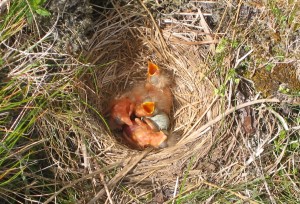
- If a nest is on the ground, and blown down, then it's probably abandoned. However, if you find a nest in a tree or bush that is seemingly "empty" leave it alone. The nest may look unused, but it may be in the process of being built, or it may be an "alternate" nest for a bird. In some species of birds, the adults actually build two or three nests as a form of prowess, but also to give females options. The female will inspect each one in turn, to see if the male has the "right stuff." If she approves she'll breed with the male and begin nesting. The alternate nests may not be used, but they are "back-up" for the female. In some of the more lecherous species of birds the male may keep several nests of females too! (Don't worry ladies, there are some species of birds where the males raise the young and the females play the field).
- Some birds become quite upset at humans who come near their nests. If you've ever seen a hawk or jay mobbed by a bunch of smaller birds you know what I mean. Give nests a wide berth, and if you are being bombarded by a bird, even if you don't see the nest, BACK OFF. Use binoculars and find a safe vantage point from which you can observe the nest without stressing out the parents. (The goshawks I worked with were so aggressive that you couldn't go near the nesting tree without a helmet or padded armor!).
- It is especially important not to bother nesting birds at all, but most especially when they are sitting on eggs, or until the eggs have hatched. Eggs need to remain at a constant temperature, and if the female can't brood (sit on the eggs) then the eggs may not develop properly. This is especially true in cooler and hotter places. In hotter places females may shade the eggs and/or bathe in creeks and streams to wet the eggs and keep them cool. She also turns the eggs to ensure that they develop properly. Disturbing the process can have a very negative effect on the eggs.
- It is illegal to keep bird feathers, eggs, egg shells, or nests. The Migratory Bird Act makes it illegal for you to keep or own parts or pieces of a bird nest without a permit. You could face fines or jail time. It is also illegal, under this act, to remove bird nests during breeding season. There are some exceptions, but not many. Please see my post about feathers and the migratory bird act for more information. In general, leave the nest and materials around the nest where you find them. Even harassing a bird near its nest is illegal, so proceed with caution! I know that our Department of Natural Resources police take this very seriously.
Things to look for when identifying a bird nest:
There are some basic things you should be looking for when trying to identify a bird's nest:
- Is there an adult bird around, calling watching, or dive-bombing you (see note above)? Finding an adult nearby is a great way to begin narrowing down what species of bird your nest comes from, though if there are many species of bird you may need more information.
- Does the bird have a brood patch? A brood patch is a bald patch of skin on a bird's chest (usually the female's) where they have removed feathers. These feathers may be used to line the nest, and may give you a clue as to the bird species of the nest. The main purpose of this bare patch of skin is to allow direct contact between the eggs and the mother's skin, keeping the eggs warm. You may not see a brood patch directly, upon first observation, but if you are banding birds you can often blow on the bird's belly and it becomes visible.
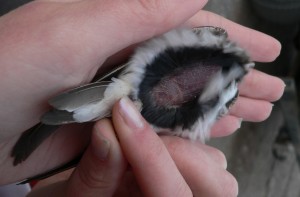
- Height of the nest- The height of the nest can sometimes give you clues as to the species of bird, though it's not a truly reliable indicator. For instance, some birds, like killdeer, are ground nesters, that hide their eggs in gravel divots in the ground. Some birds like American kestrels like extreme heights and may nest as high as the top of a telephone pole. Height should be used in combination with other features when trying to figure out the nest you're looking at.
- Size of the nest- The size of the nest is a good indication of the species of bird you are looking at (again, please remember my caution about getting near active nests). One of the best ways to estimate nest size, from a distance, is to use size comparisons like the sizes of different birds, your hand, or other common objects. For instance, you know a nest that is 5 feet wide and 3 feet deep (as wide as your arms), made from large sticks, is probably a larger bird. If the nest is the size of a quarter then it's probably a smaller bird. The mass of the nest is also a good indicator of the size of the bird, though there is no reliable scale or ratio to give you. Just follow a rule of common sense. Eagles can build nests that weigh up to 60 lbs, Carolina chickadees a few ounces.
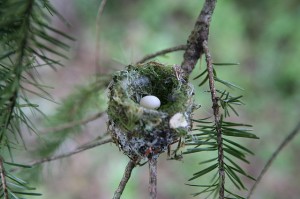
- Cup of the nest- When a bird makes its nest it usually sits in the center and pivots in a tight circle, laying down materials and weaving everything together. There are several reasons for this. When a bird sits and broods, she can make a neat "seal" over the eggs, keeping in heat and moisture (or cooling). The cup of the nest also is designed at just the right height to keep the eggs from rolling out, and to keep the young within the bowl of the nest without falling out. If the female covers the entire cup of the nest, then her back (and camouflaged feathers.. remember, females are usually a dull gray or brown) also camouflages the eggs and nest. Cup size is a good indication of diameter of the chest size of the bird you're looking at. Now this can become much more difficult with nests on cliff faces, the ground, or a jumble of sticks, but it's a good start!
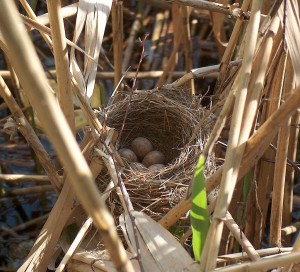
- What it is made out of- Birds are fairly predictable by species about what they prefer to make their nests out of, though this can change based on the region you live in. For instance, barn swallows always use daubed mud, Eastern blue birds prefer straw or grass, and Carolina chickadees like shallow bowls of moss. Tree swallows like to add in feathers and hummingbirds often use spiderweb silk to hold their nests together. In some cases birds will use man-made objects like Easter grass, plastic bags, and wrappers. You may even find snake skin or dog/deer/horse/rabbit fur lining a nest. I've seen Barbie, lawn chair pieces, plastic bags, TV antennae, fishing poles, and even clothing like bathing suits in osprey nests. One major problem though, is fishing line or plastic bags. These can snare the young and adults. If you can, police your region regularly and make sure these are not available (and tempting) to birds. A good bird nest field guide can walk you through the different types of nesting materials that birds prefer (see resources at the end of this post). If you want to help birds that are nesting, you can leave your combed dog/cat/horse/or human hair in a suet basket near your bird feeder. You might be surprised who takes a yank. Don't be fooled though. I've found nests made of shredded cedar bark in my bird boxes. It was from flying squirrels, and man will they give you a heart attack if you open a box not expecting one!
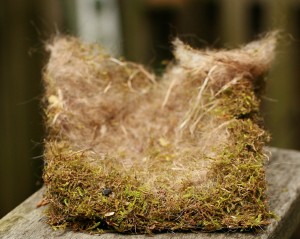
- Additional things to look for- Nests can be very surprising places, because you may find things you didn't expect. For instance, some species of birds parasitize the nests of others with their eggs. Brown cowbirds (birds about the size of a starling) will lay their eggs in the nests of smaller species, like warblers. The chick that hatches is quite large, and ends up pushing out the eggs and nestlings of the original parents, killing them. Left behind is a chick 5x bigger than the parents feeding it, but the parents don't seem to know the difference! You should also look to see if ants are invading the nest, or if you see red mites on the nest. There's not much you can do about mites or parasites, but it may give you a clue as to the health of the adults and chicks. In my bird boxes that are empty, but colonized with ants, I pour a bit of cinnamon to keep them out. It's an old bee keepers trick. You can also use white Ivory soap rubbed around the base and entrance of a bird box to keep out wasps that try to start paper nests. Never EVER use chemically-based pest control.

- Type of tree, shrub, ground, cavity, or hole? Some birds are not overly picky about specific types of trees or shrubs that they use. They are more concerned with ingress and egress, safety from predators, height of nest, etc. However, there are a few exceptions, like woodpeckers and other cavity nesters. They are opportunistic about tree holes, but the holes must be a specific size (see bird nest field guides for this information), large enough to let the adult in and small enough to keep out predators our out of reach of predators. Some species of owls and woodpeckers even will nest in tall cactuses. Many ground nesters also work quite hard to make difficult to see the nests. For instance turkeys, mallards and other ducks, geese, and killdeer all do this. With these birds, watch where you step! If you see a bird pretending that it has a broken wing, like a killdeer, then you're close to her nest, and she's trying to lure you away with her "easy prey" act. Female turkeys will sometimes not even leave the nest until you're right on top of them. I have been scared out of my wits more than once by a 20+ lb bird flying up at full speed when I wasn't expecting it!
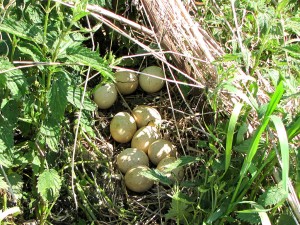
- Is there poop on the ground directly below the nest? When I was taught to look for bird nests, especially predatory birds and owls, I was told to look for "whitewash." Whitewash is simply a white coating of bird poop on or around a tree, rock face, or building. It's often a good sign of bird roosting activity.
- Are there prey remains, pellets, or feathers around the base of the nest? Many birds of prey, crows, and jays are messy eaters. I had more than one park visitor complain about body-bits of small mammals being dropped from them overhead while hiking. The baby owl-lets were just having a good meal! You can often spot nests (and ID who is in them) by what is below them, and not only food and feathers, but also pellets or the compact regurgitated remains of meals from owls and other birds of prey. They are quite fascinating to take apart, but use gloves, they can carry salmonella. There are even companies online that will pay you for them!
- Are there "poop sacs" around the nest, or within 10-20+ feet? Some birds don't care if the babies poop on or in the nest, while others are the opposite. Some female birds, like sparrows and swallows, will pick up their babies small "poop sacs" and carry them several yards from the nest before dropping them. More than once I've seen a helpless victim of this "bombing." It sounds gross, but helps reduce the amount of fecal smell around the nest, and keeps from drawing predators.
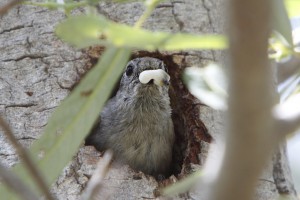
- Egg color- When an egg moves down the tube from the ovary, and the shell is laid down around it, it is also "pigmentized" or given color. This color varies depending on the diet of the bird, and the region the bird lives in. Often times you will see spotting or streaking, which applied as the egg turns going down the tube. These colors are pretty good indicators for the species of bird nest you find, but they can be tricky, because there is some variation in pattern, size, and color. Picking the right color and pattern out of a field guide can be confusing, rather like choosing a paint chip pattern from the store. Fortunately, most good bird field guides also offer pictures of what the different (similar) types of eggs should look like, and their exact size, which helps. Try to take a picture of the eggs from your binoculars, or at a distance, so that you can use your bird book for comparison.

- Egg shape and size-As I mentioned earlier, egg size is often shown in most good egg and hatchling field guides, but shape is also important. Birds that lay eggs in cup nests typically have stubby rounded eggs, while birds that are ground nesters or cliff layers have eggs with a more conical point. This is because the conical point allows the egg to roll in a circle, rather than "away" or off the cliff/nest. Look closely at the size and shape of the egg, this will give you an idea of what type of bird it comes from. Obviously, if the egg is bigger than a chicken, it's not a hummingbird!
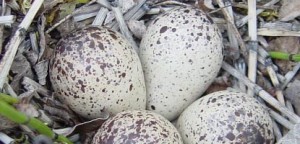
- Fledgling size and coloring-The size of the young will also give you a idea about the type of bird you're looking at. Remember though, when they are fledglings their early "down" phase of feathers may be dark, with lighter feathers coming in later. As a rule, baby birds more closely resemble adult female birds early in life, because then the males then don't see them as a threat and attack them. Use a good field guide to help you identify the color phases of different fledglings. As mentioned earlier, if you have small birds in a nest with one whopper of a big bird, you have a cowbird parasite hatchling!
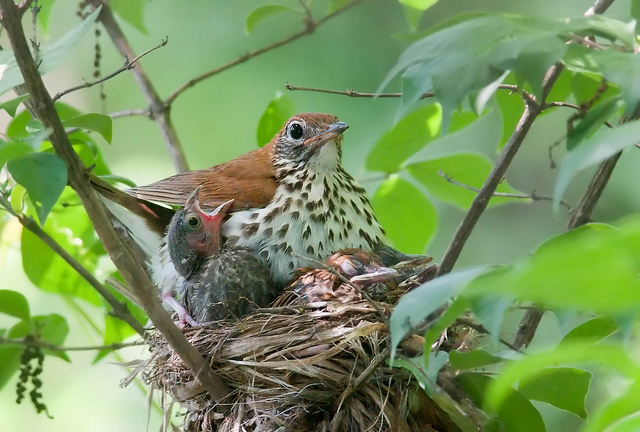
- Fledgling beak and feet color-The beaks of fledglings are also indicative, along with their feet (which are much harder to see). Beak color can range from yellow to orange and even dark or blackish. Feet can also be yellow, orange, or pale colored. Use your field guide to look for clues.

These ideas are just the tip of the iceberg when it comes to identifying nests and fledgling. Here are a few resources that can be quite helpful:
BOOKS TO HELP YOU IDENTIFY BIRD NESTS AND NESTLINGS
- Nests, Eggs, and Nestling of North American Birds (Princeton Field Guides) See note below.
The Princeton field guide by Baicich and Harrison is, by far, the best resource. It has wonderful color plates of eggs (in life size for comparison), great pictures of the different stages of fledglings (feathering etc), and gape pictures that show you the open beak colors of the young. It runs about $15 dollars, but is worth the cost.
- Peterson Field Guide to Eastern Bird Nests -----Warning: this book is from 1975, but is still sold. The pictures are still useable, but it's an old book with old names and classifications. I was also a little disturbed by how they took the pictures, it appears that nests have been removed or cut out of their locations, or in some cases even cut out of cliffs, or trees in the case of woodpeckers out of trees.
- Fifty Nests and The Birds That Built Them (Dumbacher et. al)
- Avian Architecture, How Birds Design, Engineer, and Build (Goodfellow)
- Birds, Nests, and Eggs (Children's Take Along Guide)
OTHER RESOURCES
- Cornell Ornithology Lab: Project Nest Watch
- Cornell, Examples of Nests and Eggs
- Wild Birds Unlimited: Recognizing Common Backyard Nests
- Northern Woodlands Magazine
ACTIVITY FOR CHILDREN
An activity that I like to do with children, to instill nest appreciation with them, is to have them try to build a nest for a "model" or pretend egg. You can make this as messy or clean as you like. I have run this activity outside (for ages 5-12), with buckets of mud and sticks. I tell students that they won't have to build it with them mouth, like birds, but they have to make a cup, make it stable, able to withstand wind (I'll come by with a fan and blow on it), rain (I'll use a watering can on it), and it has to hold an egg that won't fall out. I usually have them build it on a table, for younger students, but for older students you can challenge them to built it on a low tree limb (with or without mud, sticks work just fine).
Bird nests are wonders of architecture, and truly a marvel. Remember to appreciate them at a distance, and enjoy the presence of your feathered friends. You can encourage them by leaving out dog fur, hairbrush fur, nesting materials such as straw and hay, or putting up bird boxes. Provide food, water, and shelter, along with space, and they will come!


